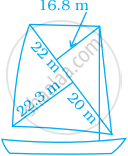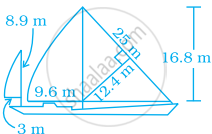Advertisements
Advertisements
Question
A sweet is in the shape of rhombus whose diagonals are given as 4 cm and 5 cm. The surface of the sweet should be covered by an aluminum foil. Find the cost of aluminum foil used for 400 such sweets at the rate of ₹ 7 per 100 sq.cm
Solution
Diagonals d1 = 4 cm and d2 = 5 cm
Area of one rhombus shaped sweet = `1/2` (d1 × d2) sq.units
= `1/2` × 4 × 5 cm2
= 10 cm2
Aluminum foil used to cover 1 sweet = 10 cm2
∴ Aluminum foil used to cover 400 sweets = 400 × 10 = 4000 cm2
Cost of aluminum foil for 100 cm2 = ₹ 7
∴ Cost of aluminum foil for 4000 cm2 = `4000/100 xx 7` = ₹ 280
∴ Cost of aluminum foil used = ₹ 280.
APPEARS IN
RELATED QUESTIONS
If length of a diagonal of a rhombus is 30 cm and its area is 240 sq cm, find its perimeter.
The perimeter of a rhombus is 40 cm. If one diagonal is 16 cm; find:
- It's other diagonal
- area
The length of the diagonals of a rhombus is in ratio 4 : 3. If its area is 384 cm2, find its side.
Find the area of a rhombus whose base is 14 cm and height is 9 cm.
Find the missing value.
| Diagonal (d1) | Diagonal (d2) | Area |
| 19 cm | 16 cm |
The area of the rhombus when both diagonals measuring 8 cm is
The area of the rhombus is 128 sq.cm and the length of one diagonal is 32 cm. The length of the other diagonal is
The height of the rhombus whose area 96 sq.m and side 24 m is
Most of the sailboats have two sails, the jib and the mainsail. Assume that the sails are triangles. Find the total area sail of the sailboats to the nearest tenth.

Most of the sailboats have two sails, the jib and the mainsail. Assume that the sails are triangles. Find the total area of sail of the sailboats to the nearest tenth.

